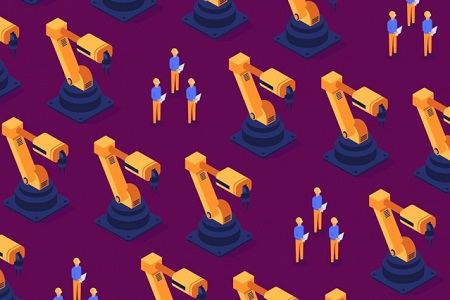
Views: 25
– The new research by economist Daron Acemoglu, from MIT, puts several figures on the labor costs of automation. (This part 1 of 3)
Courtesy MIT by Peter Dizikes: In many parts of the US, robots have been replacing workers for the past few decades. But to what extent, really? Some technologists predicted that automation would lead to a jobless future, while other observers were more skeptical of these scenarios.
Now, a study co-authored by an MIT professor puts firm figures on the trend, finding a very real impact – although one that falls short of purchasing a robot. The study also finds that, in the U.S., the impact of robots varies widely across industries and regions and can play a notable role in exacerbating income inequality.
“We found very significant negative effects on employment,” says Daron Acemoglu, an economist at MIT, although he notes that the impact of the trend can be exaggerated.
From 1990 to 2007, the study shows that the addition of an additional robot per 1,000 workers reduced the national employment / population rate by about 0.2%, with some areas in the US affecting far more than others.
This means that each additional robot added to manufacturing replaced about 3.3 workers nationally, on average.
This increase in the use of robots in the workplace also reduced wages by about 0.4% during the same period.
“We found negative wage effects, which workers are losing in terms of real wages in the most affected areas, because robots are very good at competing against them,” says Acemoglu.
The article, “Robots and Jobs: Evidence from the US Labor Markets,” appears in advance in an online format in the Journal of Political Economy. The authors are Acemoglu and Pascual Restrepo PhD ’16, assistant professor of economics at Boston University.
Displaced in Detroit
To conduct the study, Acemoglu and Restrepo used data from 19 industries, compiled by the International Robotics Federation (IFR), an industrial group in Frankfurt that maintains detailed statistics on robot deployments worldwide. Scholars have combined this with US data on population, employment, business and wages, from the US Census Bureau, the Bureau of Economic Analysis and the Bureau of Labor Statistics, among other sources.
The researchers also compared the implantation of robots in the USA with that of other countries, finding that it is behind Europe. From 1993 to 2007, American companies actually introduced almost exactly one new robot per 1,000 workers; in Europe, companies introduced 1.6 new robots per 1,000 workers.
“Although the US is a technologically very advanced economy, in terms of production, use and innovation of industrial robots, it is behind many other advanced economies,” says Acemoglu.
In the USA, four manufacturing industries are responsible for 70% of robots: automakers (38% of robots in use), electronics (15%), plastics and chemicals industry (10%) and metal manufacturers (7%) .
In the USA, the study looked at the impact of robots on 722 commuting zones in the continental USA – essentially metropolitan areas – and found considerable geographic variation in the intensity with which the robots are used.
Given the industry trends in the deployment of robots, the area of the country most affected is the headquarters of the auto industry. Michigan has the highest concentration of robots in the workplace, with jobs in Detroit, Lansing and Saginaw affected more than anywhere else in the country.
“Different industries have different footprints in different places in the United States,” notes Acemoglu. “The place where the robot issue is most apparent is Detroit. Whatever happens to car manufacturing, it has a much greater impact on the Detroit area [than elsewhere]. ”
In commuting zones where robots have been added to the workforce, each robot replaces about 6.6 jobs locally, the researchers found. However, in a subtle twist, adding robots to manufacturing benefits people from other industries and other areas of the country – reducing the cost of goods, among other things. These national economic benefits are the reason why researchers calculated that the addition of a robot replaces 3.3 jobs in the country as a whole.
The issue of inequality
In conducting the study, Acemoglu and Restrepo made a considerable effort to see if employment trends in heavy robot areas could have been caused by other factors, such as trade policy, but found no complicating empirical effects.
The study suggests, however, that robots directly influence income inequality. The manufacturing jobs they replace come from parts of the workforce without many other good job options; As a result, there is a direct connection between automation in industries that use robots and the drop in income among blue collar workers.
“There are major distributional implications,” says Acemoglu. When robots are added to factories, “the onus is on low-skilled workers and, especially, the middle class. This is really an important part of our overall research [on robots], that automation is actually a much larger part of the technological factors that have contributed to the increase in inequality over the past 30 years. ”
Therefore, while claims about machines that completely eliminate human labor can be exaggerated, research by Acemoglu and Restrepo shows that the robot’s effect is very real in manufacturing, with significant social implications.
“It will certainly not give any support to those who think that robots will take over all of our work,” says Acemoglu. “But it does imply that automation is a real force to contend with.”
Related article: Job – Workers are better replaced by robots than by colleagues